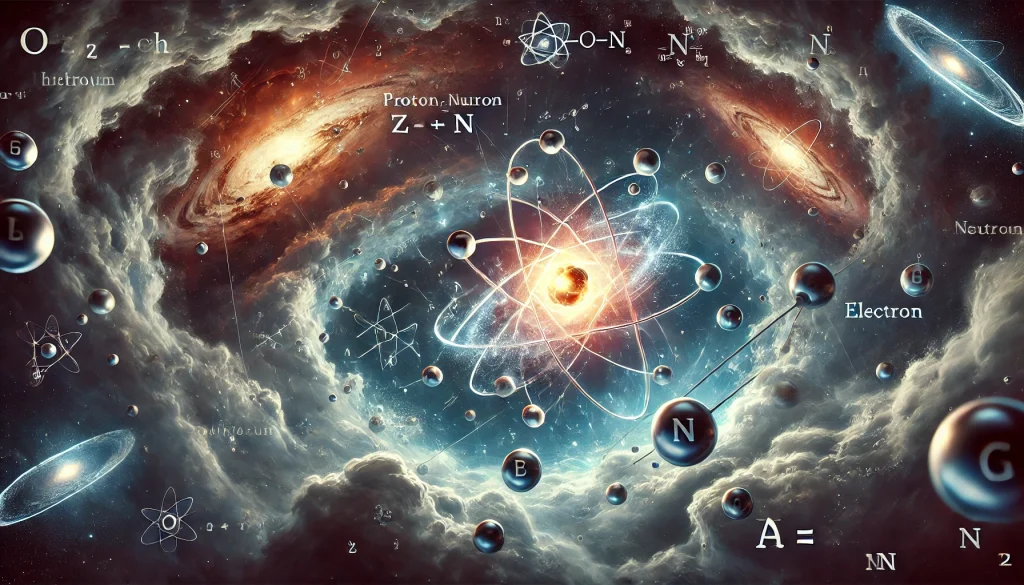The Creation and Structure of Atoms Explained

Atoms are the fundamental building blocks of matter, shaping everything from the smallest particles to the largest stars. Understanding how atoms were made leads us on a journey through the history of the universe itself, from the Big Bang to the complex structures we observe today. In this article, we’ll explore the formation of atoms, the atomic formula, and key scientific studies that have advanced our knowledge of atomic theory.
Table of Contents
The Big Bang and the Origin of Atoms
The Beginning: The Big Bang Theory
The journey of atoms begins approximately 13.8 billion years ago with the Big Bang. This cataclysmic event marked the birth of the universe, where space, time, and matter were created. In the first fractions of a second, the universe was extremely hot and dense. It wasn’t until around 380,000 years later that the temperature dropped enough for the first atoms to form.
Initially, the universe was composed of subatomic particles—protons, neutrons, and electrons—floating freely in a hot plasma. As the universe expanded and cooled, these particles began to combine, forming the simplest and most abundant element in the universe: hydrogen (H). Along with hydrogen, helium (He) and small amounts of lithium (Li) were formed in a process known as Big Bang nucleosynthesis.
Big Bang Nucleosynthesis: The First Elements
Big Bang nucleosynthesis occurred within the first few minutes of the universe’s existence. During this time, the universe was hot enough for nuclear reactions to occur, fusing protons and neutrons into the nuclei of hydrogen, helium, and trace amounts of lithium. This process explains why hydrogen and helium make up roughly 98% of the observable universe’s elemental composition.
The atomic structure of hydrogen is simple: one proton and one electron. Helium, the second most abundant element, consists of two protons, two neutrons, and two electrons. Lithium, though much rarer, has three protons, three or four neutrons, and three electrons.
These early atoms formed the basis of all matter, but heavier elements required a more complex process that occurred later in the lifecycle of stars.
Stellar Nucleosynthesis: Forging Heavier Elements
While the Big Bang created the lightest elements, the heavier elements like carbon (C), oxygen (O), and iron (Fe) were forged inside the cores of stars. This process is known as stellar nucleosynthesis, where nuclear fusion in stars combines smaller nuclei to form larger, heavier atoms.
Nuclear Fusion in Stars
Stars generate energy through nuclear fusion, a process where lighter elements such as hydrogen fuse together to form heavier elements. For example, in the Sun and other stars, hydrogen atoms combine to form helium, releasing enormous amounts of energy in the process. As stars evolve, they create heavier elements through fusion, progressing from helium to carbon, oxygen, neon, and eventually to iron.
Supernovae: The Birth of the Heaviest Elements
While elements up to iron are formed in the cores of stars, the heaviest elements in the periodic table, such as gold (Au), uranium (U), and platinum (Pt), are created in supernova explosions. When massive stars reach the end of their lives, they explode in a violent supernova event, dispersing heavy elements throughout the universe. These elements then become part of new star systems, planets, and life itself.
Supernova nucleosynthesis is responsible for elements heavier than iron, where the intense heat and pressure from the explosion allow protons and neutrons to fuse into these heavier elements. This process enriches the interstellar medium with diverse elements, which eventually become part of new stars, planets, and living organisms.
The Atomic Structure and Formula
Atoms are composed of three primary subatomic particles: protons, neutrons, and electrons. These particles combine to create the structure of an atom, which can be described using specific formulas and models.
Atomic Structure
- Protons: Protons are positively charged particles located in the nucleus of an atom. The number of protons in an atom’s nucleus defines the element and is known as the atomic number (Z).
- Neutrons: Neutrons are neutral particles also found in the nucleus. They add mass to the atom but do not affect its chemical properties. The sum of protons and neutrons gives the atomic mass number (A).
- Electrons: Electrons are negatively charged particles that orbit the nucleus in specific energy levels or shells. The number of electrons in an atom equals the number of protons, ensuring the atom is electrically neutral.
The Atomic Formula
The atomic structure of an element is often described using the formula A = Z + N, where:
- A = Atomic Mass Number (the total number of protons and neutrons)
- Z = Atomic Number (the number of protons)
- N = Neutron Number (the number of neutrons)
For example, carbon (C) has an atomic number (Z) of 6, meaning it has 6 protons. A typical carbon atom (C-12) has 6 neutrons, making its atomic mass number (A) 12. The formula would be written as:
- A = Z + N
- 12 = 6 + 6
For isotopes, the atomic number (Z) remains constant, but the neutron number (N) can vary, leading to different atomic mass numbers. For example, carbon-14 (C-14), a radioactive isotope of carbon, has 6 protons and 8 neutrons, giving it an atomic mass number of 14.
Key Scientific Studies on Atomic Theory
The discovery and understanding of atoms have been shaped by centuries of scientific inquiry. Here are some of the pivotal studies and experiments that have advanced atomic theory.
1. John Dalton’s Atomic Theory (1808)
John Dalton is often credited with the first modern atomic theory, which he proposed in 1808. Dalton suggested that elements are composed of tiny indivisible particles called atoms, and that atoms of a given element are identical in mass and properties. His theory laid the foundation for modern chemistry and our understanding of atomic structure.
2. J.J. Thomson’s Discovery of the Electron (1897)
J.J. Thomson’s experiments with cathode rays led to the discovery of the electron in 1897. By demonstrating that cathode rays were composed of negatively charged particles much smaller than atoms, Thomson introduced the concept of subatomic particles, challenging the idea that atoms were indivisible. He proposed the “plum pudding” model of the atom, where electrons were embedded in a positively charged “pudding.”
3. Ernest Rutherford’s Gold Foil Experiment (1911)
Ernest Rutherford’s famous gold foil experiment in 1911 revolutionized atomic theory. By firing alpha particles at a thin sheet of gold, Rutherford observed that some particles bounced back, leading him to propose that atoms have a small, dense, positively charged nucleus at their center. This discovery replaced Thomson’s plum pudding model with the nuclear model of the atom.
4. Niels Bohr’s Model of the Atom (1913)
Niels Bohr further refined Rutherford’s model by introducing the concept of quantized electron energy levels. Bohr suggested that electrons orbit the nucleus at specific distances and can jump between energy levels by absorbing or emitting photons. This model helped explain atomic spectra and paved the way for the development of quantum mechanics.
5. Quantum Mechanics and Modern Atomic Theory
In the 20th century, quantum mechanics revolutionized our understanding of atomic structure. The work of scientists like Erwin Schrödinger, Werner Heisenberg, and Paul Dirac led to the development of the quantum model of the atom, where electrons are described as probability clouds rather than fixed orbits. This model provides a more accurate description of atomic behavior and interactions.
Conclusion: The Birth and Structure of Atoms
Atoms are the building blocks of all matter, formed in the fiery birth of the universe through processes such as Big Bang nucleosynthesis, stellar nucleosynthesis, and supernova explosions. Their structure, composed of protons, neutrons, and electrons, is fundamental to our understanding of chemistry and physics. Through centuries of scientific discovery, from Dalton’s atomic theory to the quantum mechanical model, we have come to understand the intricate nature of these tiny particles.
Atoms not only shape the universe around us but also define our very existence. Their creation and structure offer profound insights into the origins of matter and the evolution of the cosmos, providing a foundation for future discoveries in physics and beyond.


